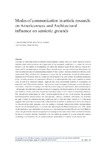Mostrar o rexistro simple do ítem
Modes of communication in artistic research: on Americanness and Architectural influence on semiotics grounds
| dc.contributor.author | Stähl, Lars Henrik | es_ES |
| dc.contributor.author | Sandin, Gunnar | es_ES |
| dc.date.accessioned | 2014-10-02T12:32:04Z | |
| dc.date.available | 2014-10-02T12:32:04Z | |
| dc.date.issued | 2012 | es_ES |
| dc.identifier.citation | Culture of communication / Communication of culture, 2012: 1089-1100. ISBN: 978-84-9749-522-6 | es_ES |
| dc.identifier.isbn | 978-84-9749-522-6 | es_ES |
| dc.identifier.uri | http://hdl.handle.net/2183/13472 | |
| dc.description.abstract | [Abstract] In relation to traditional modes of research within academic context, there is a recent interest in research methods where artistic practices set a larger part of the managerial guidelines, i. e. where the artist or artwork is not the subject of investigation, but rather the operative agent for the carrying through of a project and for the dissemination of results. These methods are by necessity tied to more idiosyncratic and more experimental ways of communicating research. From a «pure» conveying perspective this may seem controversial: Why introduce new interpretative layers into the academically formalized frameworks of communication? However, from an «empirical» art perspective, as well as from the semiotic perspective of the pervasive presence of «vagueness» (Peirce), it is understandable that certain qualities in artistic work, as well as in empirical research, might get lost when conventional methods of investigation are setting the norm. When artistic methods – like practice-based investigatory techniques, critical institutional intervention, unforeseen technologies of information processing, and experimental modes of dissemination – are brought into traditional academic modes of investigation, the benefit seems to be of a reciprocal sort: both academia and art world may conquer pre-conceptualization in their respective knowledge traditions. The conventional terminology by which research applications, as well as art projects, are generally described generally include notions like «background», «theory», «method», «relevance», etc, and these are used to reach an understanding from experts as well as from non-expert readers. It is in this paper suggested that such basic concepts could be discussed also in relation to another set of terms, less frequent but relevant for this field: «ground», «wit» and «margin». «Ground» relates to the abstract correspondence between two distinct phenomena, as in iconic and indexical ground (Peirce, Sonessson, a o). «Wit» stands for the conclusive logic mechanism of a humorous or non-humorous creation (Freud, a o). And «Margin» is here thought of as the reduced or neglected surroundings to a thematic context that nevertheless influence the focus of thematic attention (Gurwitsch, a o). An underlying question is to what extent the common terminology is also decisive for the communicational performance of research within creative arts. | es_ES |
| dc.language.iso | eng | es_ES |
| dc.publisher | Universidade da Coruña | es_ES |
| dc.title | Modes of communication in artistic research: on Americanness and Architectural influence on semiotics grounds | es_ES |
| dc.type | info:eu-repo/semantics/conferenceObject | es_ES |
| dc.rights.access | info:eu-repo/semantics/openAccess | es_ES |






